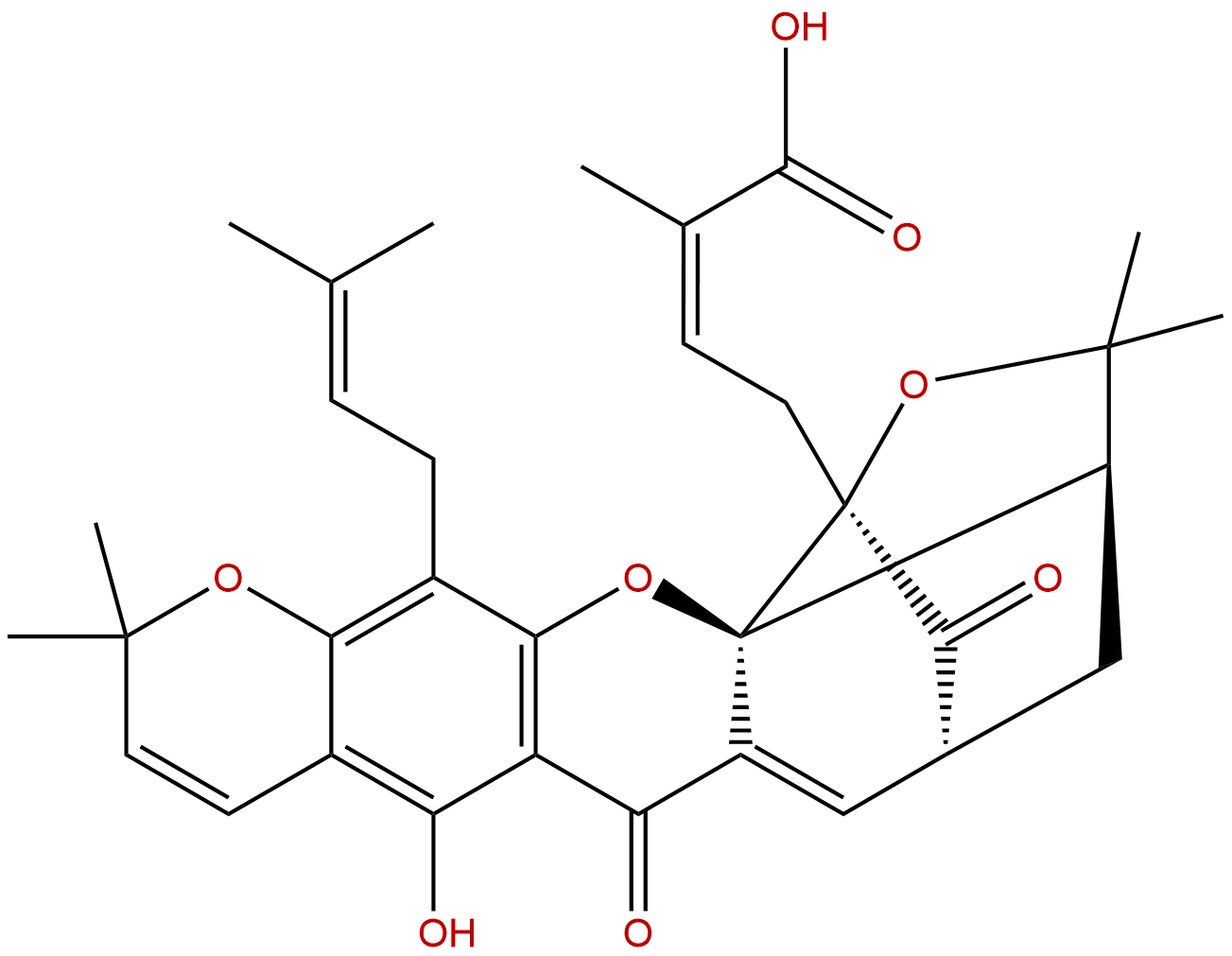
Morellic acidCAS No.:5304-71-2
|
||||||||||
 |
|
|
||||||||

| Catalogue No.: | BP1702 |
| Formula: | C33H36O8 |
| Mol Weight: | 560.643 |
Product name: Morellic acid
Synonym name: Gambogoic acid B
Catalogue No.: BP1702
Cas No.: 5304-71-2
Formula: C33H36O8
Mol Weight: 560.643
Botanical Source: Garcinia lateriflora and Garcinia morella (batuan)
Physical Description: Powder
Type of Compound: Miscellaneous
Purity: 95%~99%
Analysis Method: HPLC-DAD or/and HPLC-ELSD
Identification Method: Mass, NMR
Packing: Brown vial or HDPE plastic bottle
The product could be supplied from milligrams to grams. Inquire for bulk scale.
We provide solution to improve the water-solubility of compounds, thereby facilitating the variety of activity tests and clinic uses.
For Reference Standard and R&D, Not for Human Use Directly.
Description:
Morellic acid has anti-cancer activity, it strongly inhibited the migration of HUVEC at a low concentration of 0.5 µM in HUVEC cell migration assay in vitro. Morellic acid also has antiangiogenic activity.
References:
Biomedical Chromatography, 2008, 22(6):637-644.
Improved high-performance liquid chromatographic method for simultaneous determination of 12 cytotoxic caged xanthones in gamboges, a potential anticancer resin fromGarcinia hanburyi.
The potential anti-tumor activity of gamboges, a herbal medicine derived from Garcinia hanburyi, has increasingly gained the interest of scientist worldwide. The major components of gamboges are cytotoxic caged xanthones.
METHODS AND RESULTS:
In the present study, an improved HPLC method was developed to simultaneously quantify 12 caged xanthones, including three pairs of epimers and four pairs of trans-cis isomers, i.e. forbesione, isoMorellic acid, Morellic acid, R-30-hydroxygambogic acid, S-30-hydroxygambogic acid, isogambogenic acid, gambogenic acid, gambogellic acid, R-isogambogic acid, S-isogambogic acid, R-gambogic acid and S-gambogic acid. This method was validated to be sensitive, precise and accurate with limits of detection of 0.03-0.08 microg/mL, overall intra-day and inter-day variations less than 7.9% and overall recovery over 93.2%. The correlation coefficients (r(2)) of the calibration curves were higher than 0.995 for all analytes. The newly established method was successfully applied to reveal the difference in the chemical profiles and contents of these analytes in gamboges from different origins.
CONCLUSIONS:
It can be concluded that this method was not only an effective quality control method to ensure the safety and efficacy consistency of gamboges, but also a useful tool for screening and determining more potent cytotoxic xanthones with potential anticancer activity.
Molecules, 2013, 18(12):15305-15313.
n Vitro and In Vivo Antiangiogenic Activity of Caged Polyprenylated Xanthones Isolated from Garcinia hanburyi Hook. f.
Eleven known caged polyprenylated xanthones 1-11 were isolated from the resin of Garcinia hanburyi Hook. f., and their structures were identified by their MS, NMR and UV spectra.
METHODS AND RESULTS:
These xanthones showed significant cytotoxicities against four human cancer cell lines (HeLa, A549, HCT-116, and HepG-2) and strong inhibition against the proliferation of the HUVEC cell line in vitro by the MTT method. Furthermore, in an in vivo zebrafish model, xanthones 3 (Morellic acid), 7 (gambogenin) and 9 (isogambogenic acid) showed comparable antiangiogenic activities with less toxicities than xanthone 1 (gambogic acid), as evaluated by death and heart rates of treated zebrafish. Xanthone 7 exhibited antiangiogenic activity with no toxicity at concentrations ranging from 8 µM to 16 µM. Meanwhile, xanthones 1, 3, 7 and 9 strongly inhibited the migration of HUVEC at a low concentration of 0.5 µM in HUVEC cell migration assay in vitro.
CONCLUSIONS:
Taken together, these findings strongly suggest that xanthone 7 might be a novel angiogenesis inhibitor.